Water Department's Original Office Building
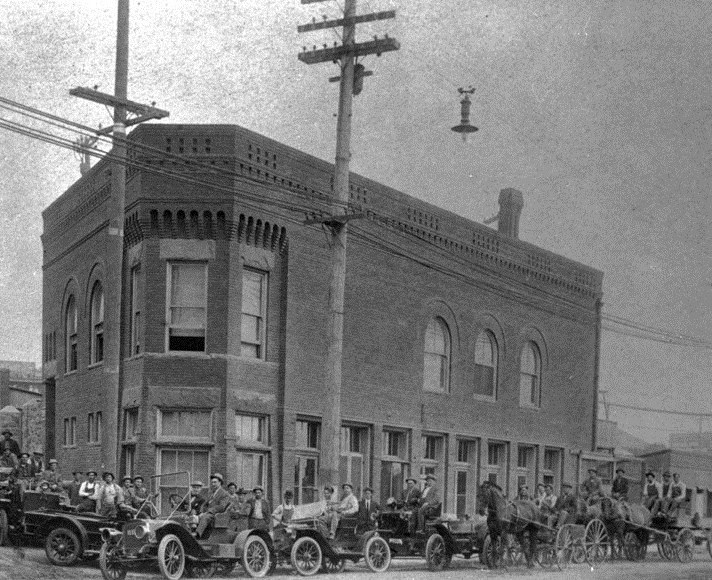 |
|
| (ca. 1912)* - Construction crews in cars and horse-drawn wagons in front of the City's first Water Department building located on the northwest corner of Marchessault and North Alameda streets (across from where Union Staion stands today). |
Historical Notes In 1868, the City of Los Angeles approved a franchise water agreement on a 30 year lease basis with the private Los Angeles City Water Company. In 1899, after the end of the lease, a $2.09 million bond measure for the purchase of LA City Water Co.’s system was approved by city voters by a margin of nearly eight to one. After over two years of litigation the City of Los Angeles finally regained control of its water system on February 3, 1902. A new department was created called the Los Angeles Water Department. Click HERE to see a more detailed timeline in Water in Early Los Angeles. |
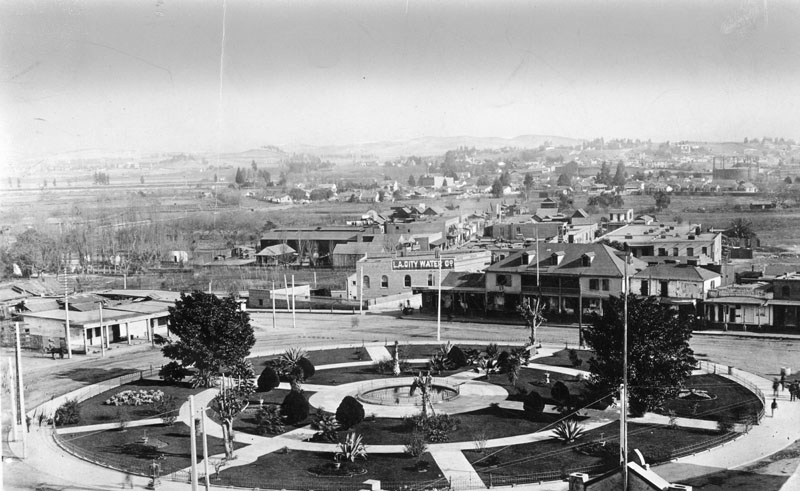 |
|
| (ca. 1892)* - View looking northeast of The Los Angeles Plaza. The LA City Water Company, with its large sign on the face of its building, is at the northwest corner of Marchessault and North Alameda. The area to the east of the LA City Water Co. building and across Alameda is now occupied by the Union Terminal. |
Historical Notes Once the purchase was completed, the Los Angeles City Water Department acquired all assets of the privately owned water system including its main office building at Marchessault and North Alameda. |
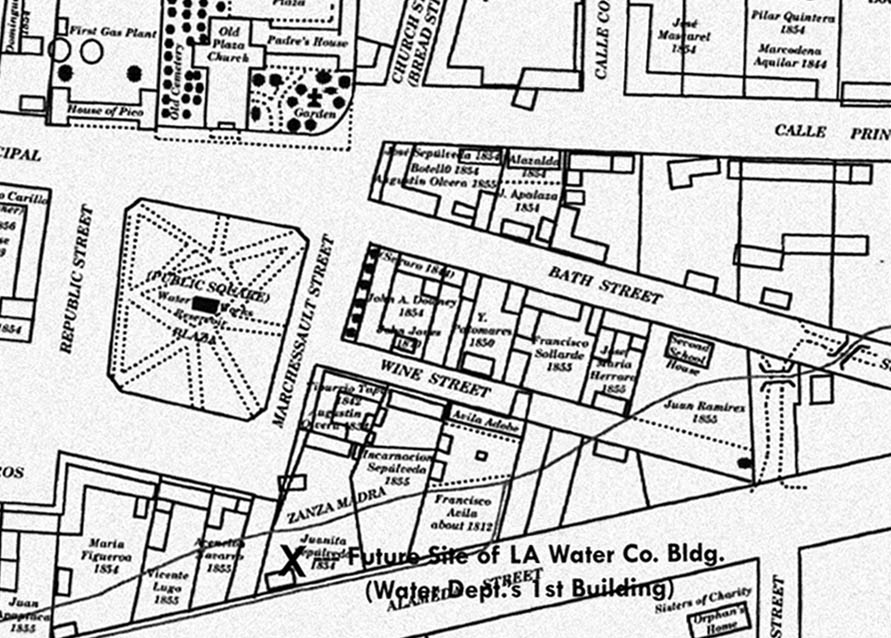 |
|
| (1873)^* - Location of the LA Water Company's Building (later Water Department's First Office Building) marked on one of the earliest maps of the Los Angeles Plaza. Note how the original Zanza Madra (Zanja Madre) ran right through the building property. |
Historical Notes The Los Angeles Water Company located its main building adjacent to Los Angeles' first aqueduct, the Zanja Madre ('Mother Ditch') on the corner of Marchessault and Alameda streets. Click HERE to see more on the Zanja Madre. |
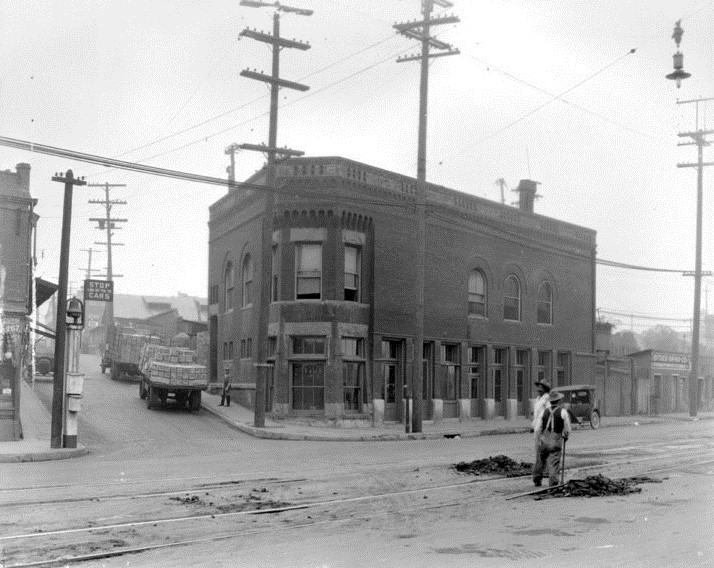 |
|
| (1920s)* - Original Water Department Building. The building on Marchessault Street was the first headquarters of the municipal Water Department in 1902 when the City resumed municipal operation of its water supply following purchase of the private LA Water Company’s distribution system. |
LADWP - Historic Archive
June 1930 – For the major portion of its existence, the old City Hall that stood for forty long years on South Broadway between Second and Third Streets, proved totally inadequate for the constantly expanding needs of the municipal government of this rapidly growing city. In similar fashion, the Department of Water and Power has suffered time and time again with “growing pains,” arising from cramped and inadequate quarters.
The original office of the Department came into its possession in 1902 as an inheritance, so to speak, from the Los Angeles City Water Company at the time of the acquisition by the municipality of this privately owned water system. This relatively small but sturdy, two-story, brick structure, originally built to house a furniture factory, stood and stands on the northwest corner of Alameda and Marchessault Streets, where it can still be seen today, tenanted by a Chinese commercial establishment, the F. Suie One Company, and also, until recently, by the Heong Chow Low, a chop suey restaurant.
Thirty years ago, the character of the surroundings of the first home of the Department left, unfortunately, much to be desired. While their quality has since changed for the better, they were then departmentally characterized as undesirable from every point of view. The offices themselves were condemned as incommodious, insufficient, inconvenient, non-central, and unsuitable to the general public. No other two indictments could possibly be stronger, it would seem. There was every incentive to move, and in 1904 the Department moved.
PECULIAR SITUATION – The situation was certainly a peculiar, not to say a contradictory one. The Plaza, upon which this building fronted, while not exactly identical with that of the original settlement at its founding in 1781, was for almost a century, even in its modified boundaries, the center of the business and social life of the community. As late even as the early eighties, the Baker Block, completed in 1878 and still standing today at the corner of North Main and Arcadia Streets, was the very heart of the retail trade center, as befitted its standing as the finest and most modern building in the Los Angeles of that period. At this time, in fact, business had only crept by degrees as far south as First Street, a distance of only about three full city blocks.
Families of position, including some of the finest of Spanish and Mexican descent, who stood on the topmost rungs of the social scale, maintained home sites facing on the Plaza, that were truly ancestral. To these they clung most tenaciously, for pride in location ran high. Was not the only church edifice in Los Angeles for many a long year – the Church of Our Lady, the Queen of the Angels – firmly rooted on one of the facing streets? Did not that resplendent church celebration, the festival of Corpus Christi, annually stage its spectacular procession around the freshly swept, decorated, and shrine-adorned Plaza? And picnic crowds, headed for the shady grove of Don Luis Sainsevain, at the foot of Aliso Street, and Fourth of July celebrations, as well, never failed to circle the Plaza. Then, also, on another facing street there was to be found in 1855, quartered in rented rooms, St. Vincent’s College – the forerunner of the present day Loyola University. Places of amusement and circuses, when they came to town, likewise stood or showed either about or directly on the Plaza itself. Next, came adornment with trees and finally, to crown all, a playing fountain in 1871.
WHY MOVE – Truly, what more could one wish or find elsewhere than on or around the Plaza? Why move away?
Upon the east side of this square, in a home about midway between the former Calle de loas Negros (now Los Angeles Street), and Olvera Street, recently rechristened as Paseo de Los Angeles (Pathway of the Angels), dwelt one of the City’s most distinguished citizens. This was no less a personage than Don Ygnacio del Valle, the father of that distinguished son, Senator R. F. del Valle, long a member and time and again president of the Board of Water and Power Commissioners. In this home, Don Ygnacio, who shone successively as Alcalde, Councilman, and State Legislator, resided until he surrendered his city abode for the greater ease and comfort of his expensive Camulos Rancho, destined for far-flung fame as the home of Ramona and the theater of action for some of the scenes of the story.
Not far from the del Valle home stood that of another notable citizen, Don Pio Pico, as striking in his personality as in his physique, and distinguished as being the last of the Mexican governors of California. Close by, also, stood one of the few two-story residences the city then boasted, the home of Don Vicente Lugo, who, as the Beau Brummel of his day, dazzled the eyes of the populace with his brilliant attire.
ABILA ADOBE – But a short distance from the Plaza, on its now renamed street, the Pathway of the Angels, formerly Olvera Street (often wrongly written Olivera), stood and still stands that structure which has of late figured so prominently in the public eye, the Abila Adobe. This was the residence of Don Jose Mania Abila, who was killed in battle in the early thirties, a century ago. His widow later conferred an enduring fame upon her home by figuring in 1847 as the entirely involuntary and yet wholly voluntary absentee hostess of Commodore Stockton during his martial sojourn in Los Angeles nearly a hundred years ago.
Again, what more could one wish or find elsewhere than on or around the Plaza?
But, sad to say, in this field abounding with so much golden wheat, there grew also the rankest of tares. As the human wheat reluctantly uprooted and transplanted itself, the human tares multiplied and spread and spread until the neighborhood came to be, for a long interval, one abounding in crime and murder, gambling halls, disreputable saloons, shady resorts, and dens of vice.
No wonder the quarter became notorious and malodorous. Reputations, we are told, is something that is easily cracked and never well mended. A lingering taint of its former evil repute still clung to the vicinity where the City acquired its first Water Office Building. Never was a characterization better justified than that so tersely phrased as “undesirable from every point of view.”^
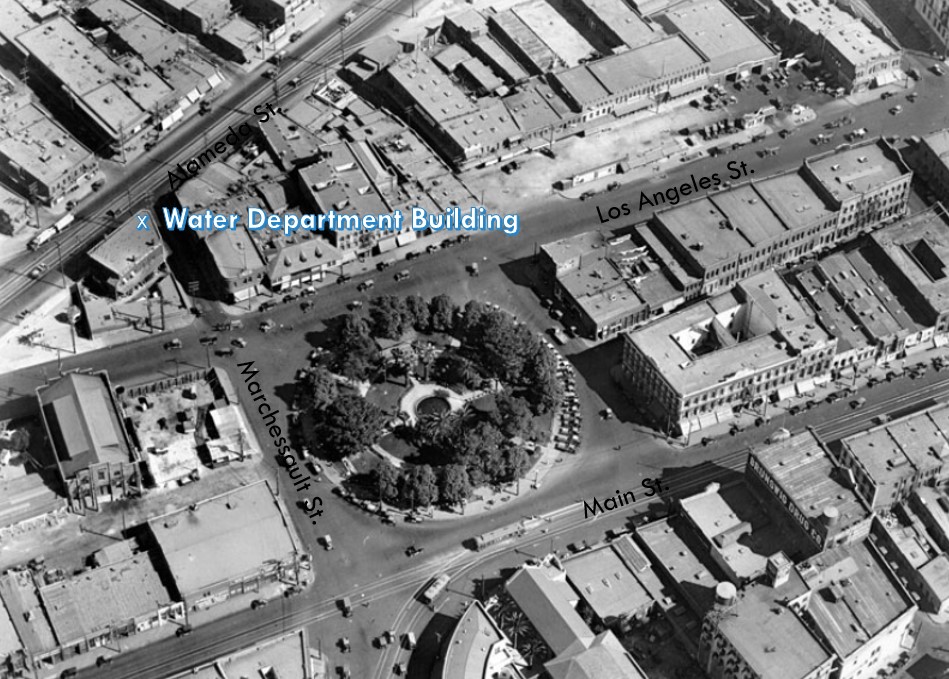 |
|
| (ca. 1924)** - Aerial view of the Los Angeles Plaza and surrounding buildings. The Water Department building can be seen in the upper left of the photo on the northwest corner of Alameda and Marchessault streets. Click HERE to see more Early Views of the L.A. Plaza. |
Historical Notes The sole occupant of the entire city block (bounded by Los Angeles, Marchessault, and Alameda streets) was a sturdy, square, two-story brick structure. Built originally for a furniture factory, it was later remodeled to serve as a headquarters of the Los Angeles Water Department’s predecessor, the Los Angeles City Water Company. |
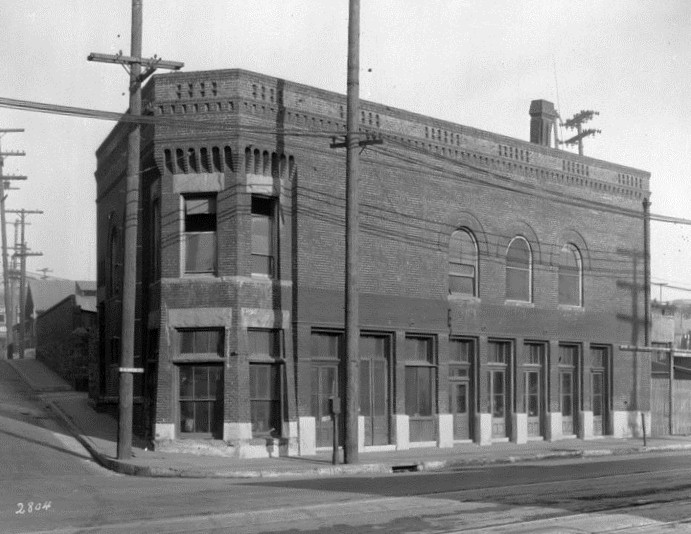 |
|
| (1920s)* - View looking west of the first home of the City of Los Angeles Water Department, n/w corner of Marchessault and Alameda. |
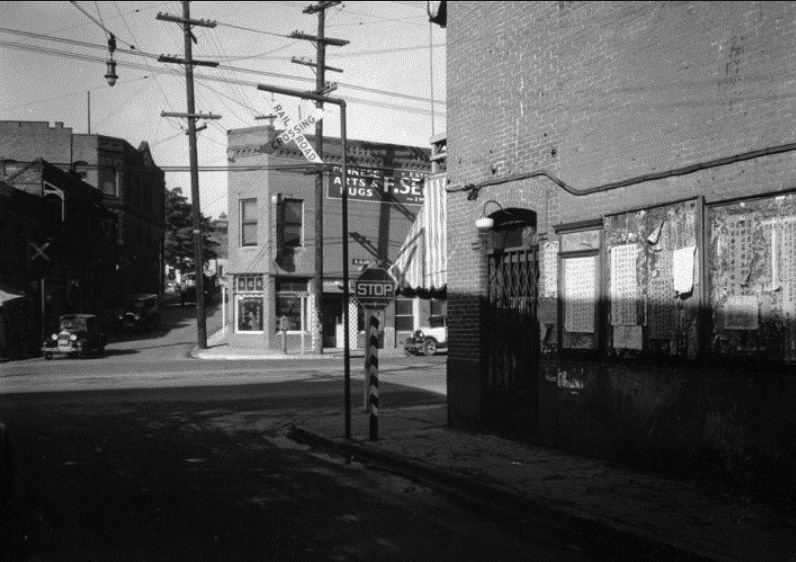 |
|
| (ca. 1929)*# – View looking west across Alameda on Marchessault Street with the old Water Department Building, now occupied by the F. See, on the northwest corner. |
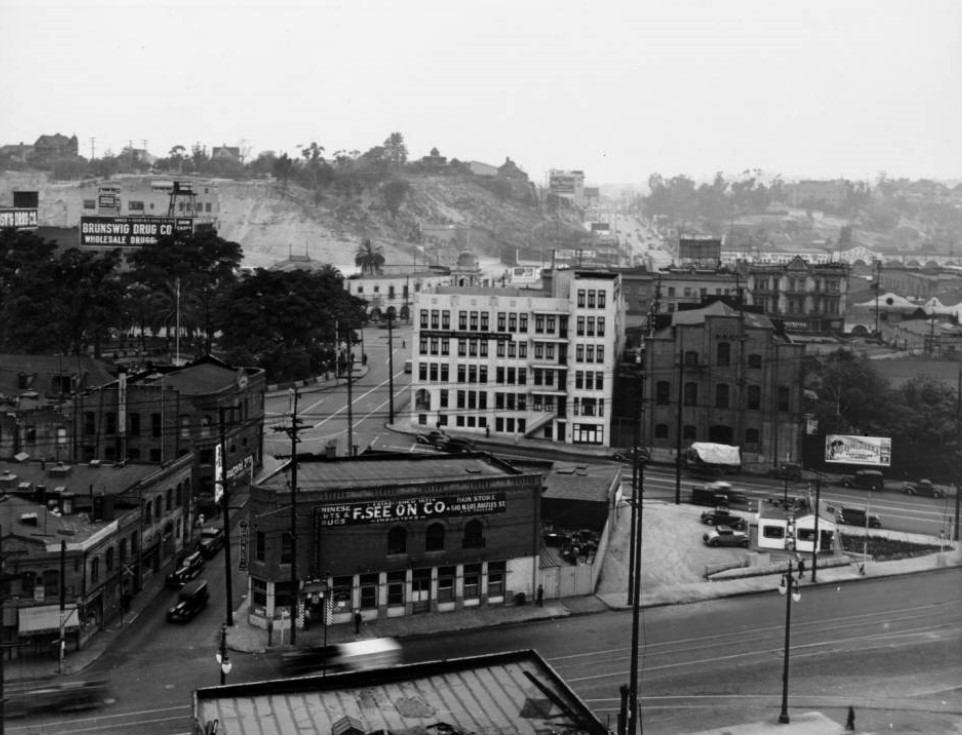 |
|
| (ca. 1939)*^ - View looking up Marchessault Street (with Alameda Street crossing at bottom and Los Angeles Street crossing at mid distance) shows the LA Plaza. The old Water Department Building, now occupied by the F. See On Company, is scheduled to be demolished. |
LADWP Historic Archive
March 1939 – The first home of the Department of Water and Power was sold last month to the City to make way for the Civic Center development planned in connection with the new Union Passenger Depot.
Located at the corner of Marchessault and Alameda Streets, directly across from the almost completed railroad station, the property was the main office of the municipal water works when the City bought out the private water companies operating here until 1902.
It was the first property listed in the indenture executed on February 3, 1902 by the Los Angeles City Water Company, the Crystal Springs Land and Water Company and the East Side Spring Water Company in transferring their holdings to the City for a consideration of $2,000,000. Value of the municipal Water Bureau plant and equipment now is in excess of $162,000,000.
The two-story brick building which in 1902 was large enough to house the entire executive and clerical forces of the water works soon was outgrown by the larger organization required to meet the expanding service requirements of a rapidly growing community.
Eventually the site fell within the limits of Los Angeles’ famed Chinatown and for some years the building has been occupied by a Chinese Restaurant and by the warehouse of a Chinese art goods importer.
Now, with the development taking place in the Civic Center, the building is to be razed and the land used in connection with the opening and widening of streets radiating from the Union Depot. Transfer of the property to the control of the Board of Public Works was approved by the Board of Water and Power Commissioners on January 31, 1939 and enacted into ordinance by the City Council on February 20, 1939.
Appraised value of the property was $50,000, but no cash was involved in the transaction. A credit of that amount was entered for the Water Revenue Fund of investment of the City Account.^
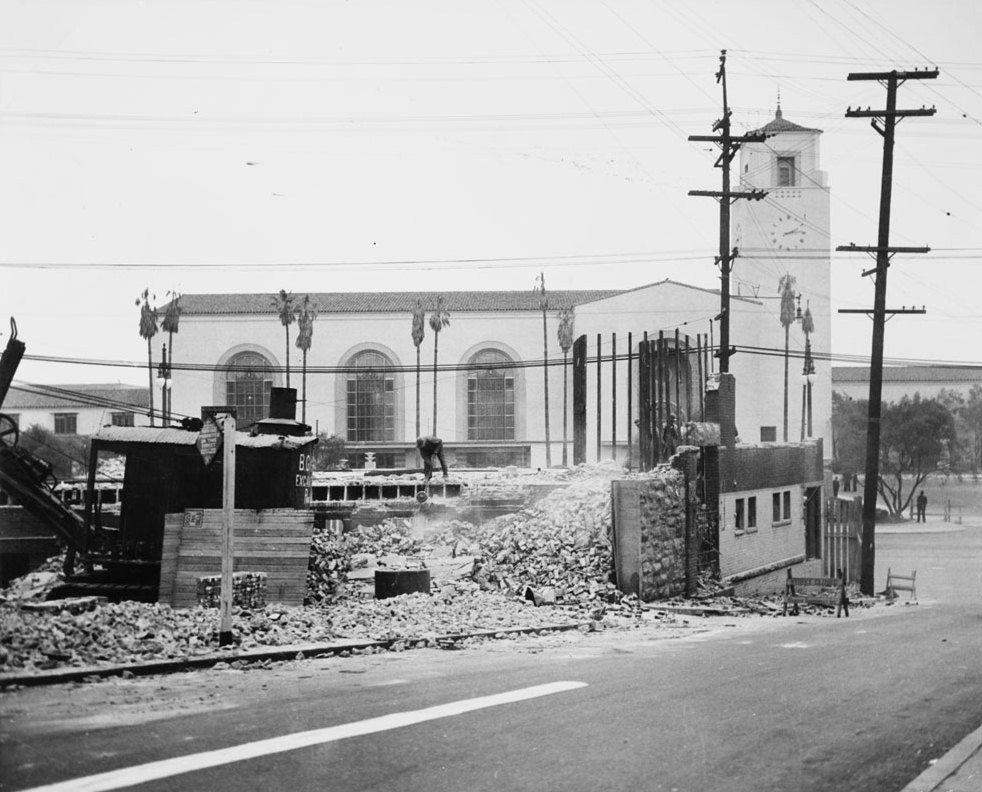 |
|
| (1939)*^ - Photo caption reads: "Another Landmark Gives Way to Progress -- Photo shows wrecking yesterday of first home of the Department of Water and Power, recently purchased by the City, to make a wide approach by way of Marchessault Street to the new Union Staion. With work being rushed, thousands of persons will occupy the site of this landmark on May 3, when the celebration's parade passes on Alameda Street. The old building was the main office of the municipal water works when the City bought out the private water companies operation here until 1902." |
Historical Notes During the wrecking of DWP's first building, workmen uncovered a section of the original Zanja Madre, LA's first aqueduct. |
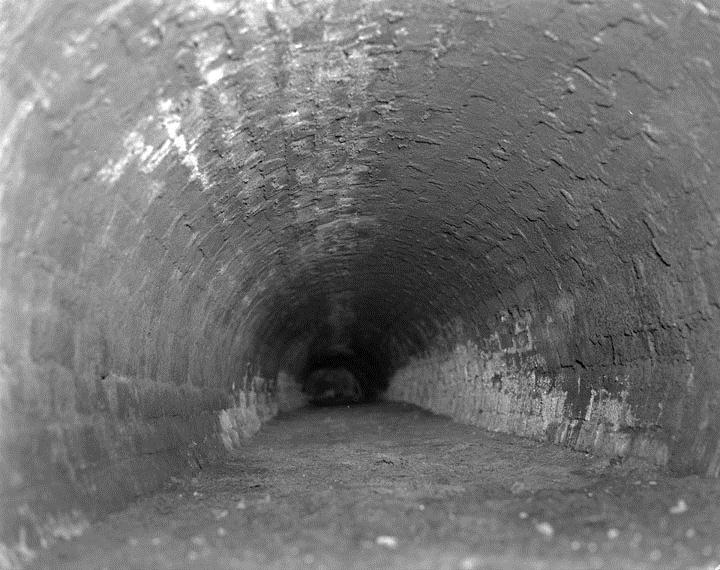 |
|
| (1939)* - Interior of Zanja Madre uncovered during wrecking of first Department of Water and Power building - The old “Zanja Madre” or mother ditch, carrier of much of Los Angeles’ water supply during the middle of the last century. Click HERE to see more in Zanja Madre - LA's Original Aqueduct |
Early DWP Office Buildings - A Short History
In 1902 the City of Los Angeles took over by purchase the old Los Angeles City Water Company and inherited the company's offices in what had been a furniture factory at Alameda and Marchessault streets (now Sunset Boulevard) across from the Plaza. Soon the municipal Water Department outgrew the little-brick building, and the search began for larger quarters. The Department relocated in 1904 at 440 South Hill Street. The Department moved in 1910 to 420-422 South Hill Street, a small one-story building on land now occupied by the Clark Hotel, however, these quarters were so crowded that less than a year later, in 1911, it was necessary to move again to a building at 636 South Hill Street, a remodeled furniture store. Here the Department functioned under its new name of Department of Public Service, comprising of the Bureau of Water Works and Supply and the Bureau of Power and Light. By 1914, growth was once again a problem and the Department leased a part of the newly completed Knickerbocker Building at 643-645 South Olive Street. In 1921 the Department purchased the seven-story Merchants Trust Building at 207 South Broadway, which was to remain its main headquarters building for forty-four years. Re-named the Department of Water and Power under the new City Charter of 1925, the Department completed construction in that year of the 13-story building at 316 West Second Street, and in 1926 completed the eight-story Hill Street building at 222 South Hill Street. These two buildings were joined with the 207 South Broadway facility to make one central headquarters complex. Continued growth of the City and the water and power services required more office space. The Washington Building at Third and Spring Streets was purchased in 1945, and the Wright and Callender Building at the southwest corner of Fourth and Hill Streets was acquired in 1946. Additional space was leased in the Subway Terminal Building from 1953 to 1958, and ten floors of the Black Building on the northwest corner of Fourth and Hill in 1958. Some central administrative offices also had to be housed in DWP buildings on the fringe of the downtown district, on Ducommun, North Main and Boylston Streets. The new General Office Building at 111 North Hope Street brought 3,500 employees of the Department under one roof when it opened in June, 1965.^*^ |
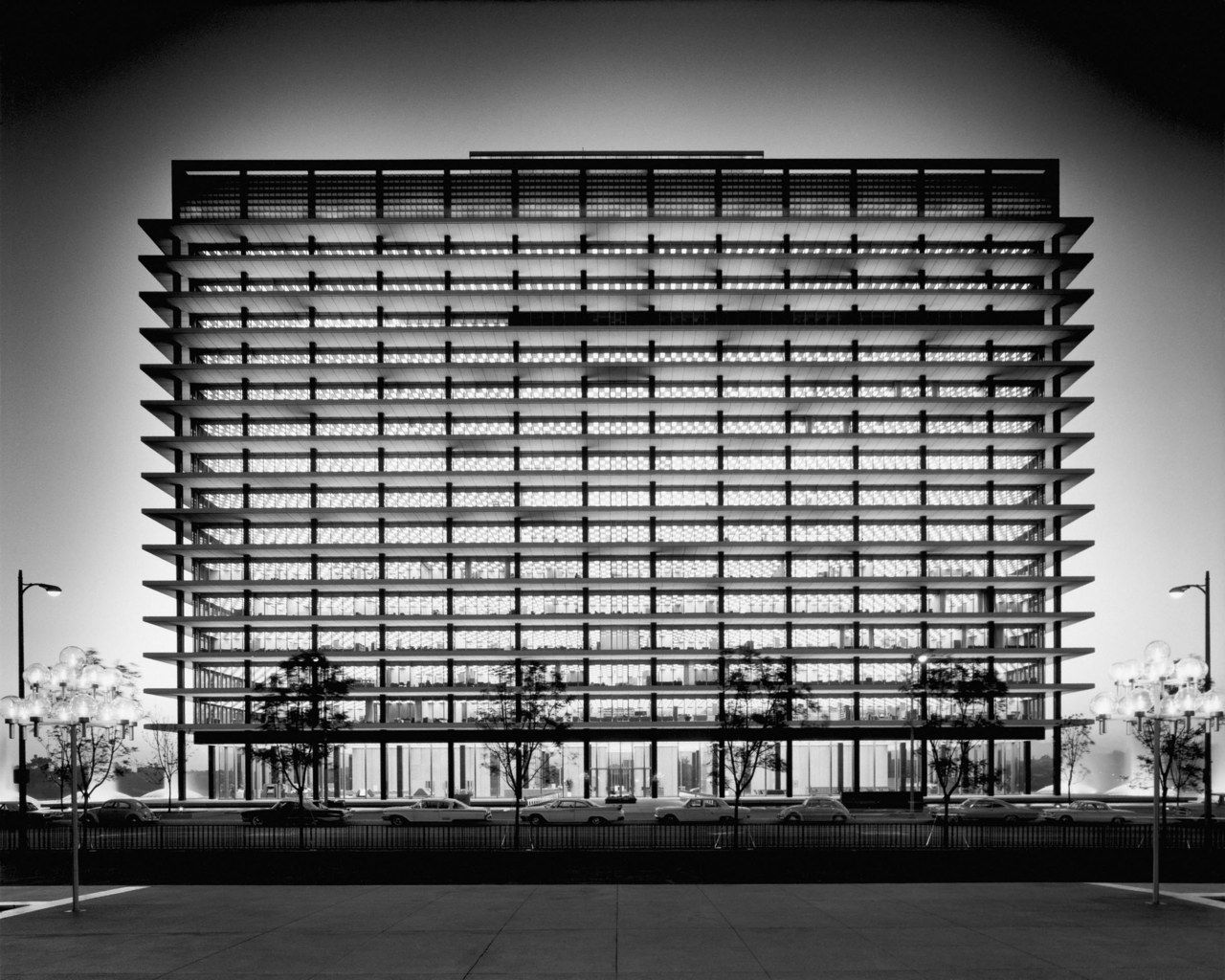 |
|
| (1965)^^ - Evening view showing the DWP General Office Building shortly after it was built in 1965, with lights and fountains on, as seen from the Music Center across the street. |
Click HERE to see more in Construction of DWP's General Office Building (GOB) |
* * * * * |
History of Water and Electricity in Los Angeles
More Historical Early Views
Newest Additions
Early LA Buildings and City Views
* * * * * |
References and Credits
* DWP - LA Public Library Image Archive
**LA Public Library Image Archive
^*Picture Gallery of Los Angeles History
^^tumblr.com:DWP Office Building
^*^Water and Power Building Pamphlet
< Back
Menu
- Home
- Mission
- Museum
- Mulholland Service Award
- Major Efforts
- Board Officers and Directors
- Positions on Owens Valley and the City of Los Angeles Issues
- Legislative Positions on
Water Issues
- Legislative Positions on
Energy Issues
- Recent Newsletters
- Historical Op Ed Pieces
- Membership
- Contact Us
- Search Index